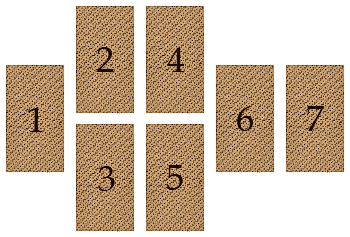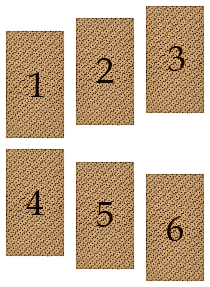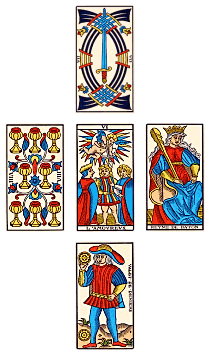


The Tarot of Ideals



A Few Spreads
“You have seen the future, Paul,” Jessica said. “Will you say what you’ve seen?”
“Not the future,” he said. “I’ve seen the Now.”
—Frank Herbert, Dune
In my humble opinion, time is imaginary. There is neither past nor future; there is only a changing present. One therefore cannot predict the future with absolute certainty. One can, however, see what direction things are moving, and sometimes make reasonable predictions based on the knowledge available. (I just jumped off of a diving board over a pool full of water; I predict that I am about to get wet.)
On the other hand, you may be headed toward Mt. Whitney, but that doesn’t mean you will get there; it is just the direction you are going. In I Ching terms, this is what I call the direction of change. Think of your situation as as a vector with a position and a direction, not a prediction of the future per se. Examples would be a compass or a weather vane; what direction is the wind blowing?
Some people perform complex readings which resemble a comprehensive personality inventory, and recommend doing readings infrequently. I favor a here-and-now, situation-dependent approach; to me, simpler spreads work better for this, and there is no reason not to do it as frequently as you want as long as you are asking good questions. It’s o.k. to ask about the outcomes of two separate choices, for example; or to reconsult if a situation has changed; but don’t ask for a “second opinion” if you already have an answer. Think first, and use respect and common sense; you wouldn’t climb a mountain to ask a guru what clothes to wear today, or make an appointment with your boss to ask how to use the pencil sharpener. And don’t bother asking if your mind is made up and you are going to reject the answer. (Don’t you hate it when people do that in real life!) If you want a yes-or-no answer, flip a coin; that is the simplest form of divination there is.
I do not use significators, and I used to prefer to use spreads with positive and negative elements rather than card reversals. But I have been using reversals more and more with open-ended spreads such as those on the next page. I do pay attention to “jumpers,” cards that fall out of your hands while shuffling or otherwise handling the deck. I see advantages to spreading and choosing the cards, but I seldom have room to do this so I usually just cut and deal them. I worry that it is too easy for small card irregularities to influence the cut, so I fan them a little in my hands then pull them apart at a place that feels right. (I suppose I am treating them as a bundle of yarrow stalks.)
What is the nature of the connection between you, the Tarot, and the rest of the world? It may be a way of training your intuition to grasp, or at least admit, things that are there but previously unrecognized. It may be the power of suggestion, giving you the motivation to take an action, or prodding you to make a choice that you are reluctant to make. It may be a form of meditation, giving you a chance to take a time out and think reflectively. It may be part of the fabric of the universe, the synchronicity of meaningful events. Or it may be something else entirely. I am not going to try to decide this one for you.
Above all, remember that the Tarot is a deck of playing cards.
The Weather Vane
I use this one all the time, often at the beginning of the week, but potentially whenever a new or uncertain situation is encountered.

Concerning your situation:
1. My place in the situation
2. Positive aspects of the situation
3. Negative aspects of the situation
4. What am I doing right?
5. What am I doing wrong?
6. What should my attitude or response be?
7. Where is this headed?
The Mirror

Concerning your situation:
1, 2. What am I doing right?
3, 4. What do I need to work on?
Two Paths

Concerning two choices:
1, 4. Pros of each choice
2, 5. Cons of each choice
3, 6. Where each choice is headed (quick version: just these two)
A Relationship
Not necessarily a romantic relationship; it could be one with a family member or coworker, or even a group or organization.

1. Me
2. The other
3. Facilitating factors
4. Barriers
5. What should my attitude be?
Negative thoughts or emotions

1. My role in this situation
2. A word of encouragement
3. What should I avoid?
4. What should my attitude be?
Single Card
What should my attitude or response be to this situation?
What should I be mindful of today?
Two Cards
Feeling kind of down at the end of the day; if you would, please
1. tell me something good about today;
2. tell me something good about tomorrow.
The Compass

|
Example: |

|
Use this spread to choose a card for each suit, and one for you in the center. Start laying cards down; place the first trump or court card that you get into the center, and discard the rest. Then continue laying cards down. When you get a suited card, place it into position. If you get a duplicate of a suit, or a trump card, discard it. Do this until you have one card of each suit at each compass point. This may be used as a general mindfulness spread, or it may represent the different facets of a specific situation.
A sample reading with the Weather Vane
I was going to meet with a group of people whom I genuinely cared about, but I had some uncertainties about the feelings and attitudes of said people, and the larger context of the situation.
While shuffling, a jumper demanded my attention: the seven of cups, a valuable opportunity concerning feelings or emotions, the inner aspect of the situation. Maybe a time to use intuition, and even have a little luck.
1. My place in the situation: the Queen of cups; genuinely nurturing and caring emotions.
2. Positive aspects of the situation: the four of cups; stable feelings among the group, or reliable, honest vibes under the surface. I had had doubts about this.
3. Negative aspects of the situation: the three of coins. This made me think of conflict or intrusion from an outside element concerning the physical situation, the literal aspects of the environment.
4. What am I doing right? The Lovers. Aww . . . .
5. What am I doing wrong? The Knight of cups. Was I trying too hard, caring as if it were a mission or assignment rather than trusting my natural feelings?
6. What should my attitude or response be? The Tower. Don’t be afraid to take on the establishment; out with the old, etc.
7. Where is this headed? The Page of rods. Fresh, new creative action, in service of a good cause; “telling it like it is.”
Outsiders from the “establishment” that I had reason not to fully trust did in fact show up, so I used the meeting as an opportunity for a little confrontation and advocacy for the group. The group responded well to the meeting; ideas came to fruition and action was taken that everyone was happy about; and afterward, surprisingly jovial and genuinely positive feelings were expressed all around. None of the negative feelings that I had worried about appeared at any time. Of note, the meeting went beyond just planning; the members were spontaneously eager to implement some of the ideas while the meeting was still going on. (Rods, not swords.)
Notice the emphasis on cups throughout.